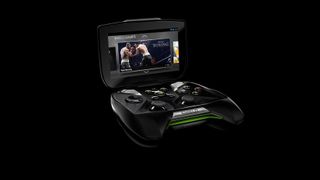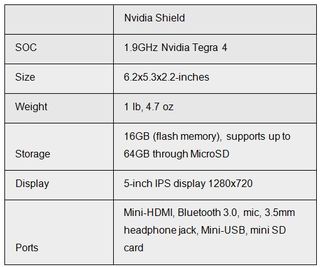PC Gamer's got your back
Cap Americas Shield
Beautiful screen; fantastic speakers; amazing battery life; powerful Android processor.
Cap America's Codpiece
Bulky; heavy; many features are still wonky.
The Nvidia Shield falls short of being a game changer
With the Shield , Nvidia aims to deliver a powerful gaming handheld centered around the Android ecosystem and the ability to stream PC games locally onto a mobile device. It’s an ambitious endeavor, but is the Nvidia Shield able to achieve those lofty goals?
The Shield is well-constructed, but is a bit too bulky.
At its core, the Shield is an Android device through-and-through, albeit a powerful one. Inside is Nvidia’s new Tegra 4 SoC clocked at 1.9GHz. In mobile performance benchmarks it scored a 19,343 in 3DMark, 4,582 in Geekbench, and 40,541 in Antutu. That makes it one of the fastest, if not the fastest, Android part out right now.
All of this graphical prowess is brought to life on a beautiful 5-inch, 720p touchscreen display that offers fantastic viewing angles. A set of phenomenal (for the size) speakers help round out the experience, even besting some laptop speakers we’ve tested.
Of course, the bulk of the handheld is taken up by the Shield’s controller, which shares the same layout and button configuration as the Xbox 360 controller. Even the construction quality is similarly solid, but at 6.2x5.3x2.2-inches, it’s a little bulkier and doesn’t contour to the hands as comfortably. Furthermore, at one pound, 4.7 ounces, the Shield is also on the heavy side, weighing a little more than two PlayStation Vitas combined. It’s a shame Nvidia couldn’t have engineered the Shield to come in at a more reasonable weight, as holding the system for extended periods can fatigue wrists. You’ll definitely want to rest it on your lap or a table for lengthy sessions.

Many Android games work great on the Shield, but unfortunately most Android games are shallow.
The center of the controller is where you’ll find several physical Android buttons for home, back, volume, start, and the games launcher. One surprising omission is the lack of any haptic feedback at all, which according to Nvidia was done to save on weight.
As for the operating system, the Shield currently runs a nearly stock version of Android Jelly Bean version 4.2.1. While this may not be the newest version of Android—4.3 at the time of this writing—Nvidia says its goal is to provide the latest OS updates within eight weeks of Google’s release. So this means you can use the Shield just like any other Android device. All your favorite Android apps can carry over and you’ll be able to watch movies, listen to music, and surf the web just as you would expect to. Still, it’s not a perfect Android experience, as the bulky controller can get in the way of accessing the touchscreen keyboard. Thankfully, the battery life is excellent. Even after watching a four-hour 1080p video on the Shield, the device still had 79 percent battery life left.
But you probably don’t intend to buy the Shield to just watch movies, so let’s get to the real meat of the device: the gaming! Here the Shield offers three options: Android gaming, the ability to stream PC games from your desktop to the device, and emulators. Android games work great on the Shield, provided the games support controllers. We counted about 100 at this point. Unfortunately, some popular standouts such as Crazy Taxi and Need for Speed: Most Wanted do not. The bigger problem with Android games currently is that many are tailored to touch-only devices and are extremely shallow experiences as a result. Furthermore, trying to play with the touchscreen here is quite cumbersome as the bulky controller gets in the way. Although the future of Android games is ever-evolving, it requires too much blind faith for us to trust at the moment.

The Nvidia Shield features a silver magnetic backplate. You can get them in different colors, but they cost $20 each.
Perhaps the most interesting feature of the Shield is the ability to stream PC games from your desktop locally over Wi-Fi, sort of the way the Wii U can stream to its tablet controller, but it’s marred by some unfortunate setbacks. In order to take advantage of this feature, you’ll need a GTX 650 video card or higher and a dual-band router. While we were set on the GPU-side with our Titan, we tried testing the Shield with a typical Linksys E1200 home router. This $45 single-band router couldn’t cut it. Switching to a $140 Asus RT-N66U Dark Knight dual-band, the streaming worked well for the most part with minimal compression and input lag. But even with this premium router, we would still experience random fits of disconnects.
Another disappointment we had is that the Shield is supposed to work with any controller-supported game on Steam, and while it did work flawlessly on the dozen titles we tried it on, we couldn’t get the Shield’s controller working with Final Fantasy VII or Sonic & All Stars Racing Transformed, even though both titles work well with an Xbox 360 controller. It’s worth noting that this streaming service is still in beta, so these issues may eventually be resolved, but it’s again an issue of faith.
Surprisingly, the most compelling way to game on the Shield at the moment is with emulators. It’s remarkable how well classic console games run on this thing with little-to-no tinkering. Still, do you want to pay $300 for a portable emulator? No matter how kick-ass that emulator may be, that’s not pocket change.
We like the Shield a lot, but its steep price tag, great barrier to entry, various bugs, and bulk leave something to be desired at this point. It’s a solid freshman effort, but if Nvidia hopes for the Shield to be anything more than a niche product, it still has a lot of work to do.
$300 , www.nvidia.com
Specifications


